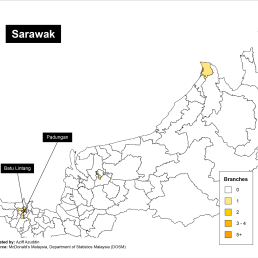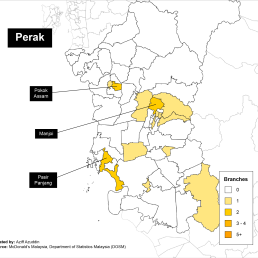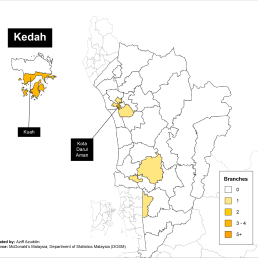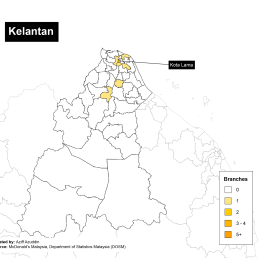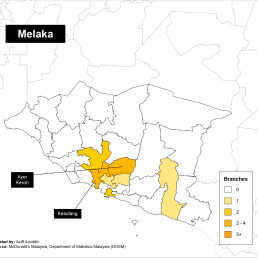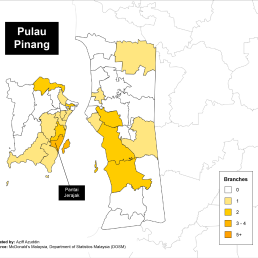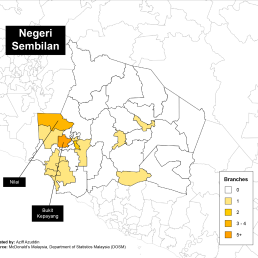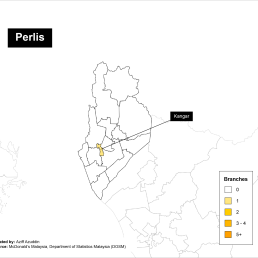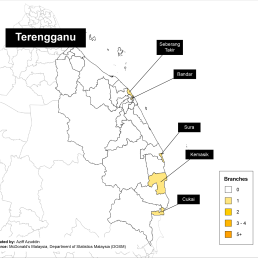What does the presence of a McDonald’s say about an area’s urban development? In the Malaysian context, McDonald’s is seen as a feature of localised progress and urban development. This is exemplified best through statements by politicians – in the recent 15th General Elections, a political candidate promised to set up a McDonald’s in his constituency if he won1Mutalib Uthman [@mutalibuthman] (2022) ‘MUDA ialah counter-culture. Kita bawa politik fun. Kita bawa politik cool. Yang penting kerja masih jalan! #MasjidTanahKitaPunya #MutalibUthman #PRU15 https://t.co/7UFLPiKulC’, Twitter. Available at: https://twitter.com/mutalibuthman/status/1593458076148912129. In another instance, a former politician claimed the establishment of a McDonald’s in his constituency when asked about his contributions to his area2Manzor, Z. (2020) Maszlee bersyukur McDonald’s di Simpang Renggam, Kosmo Digital. Available at: https://www.kosmo.com.my/2020/10/07/maszlee-bersyukur-mcdonalds-di-simpang-renggam/.
An interesting link is formed in the public imagination when a McDonald’s supposedly signals local development. While the presence of a fast food restaurant is not a sure indicator of urban development, it gives us clues about an area’s demographic, urban build and socioeconomic state. McDonald’s Malaysia intends to invest RM1.35 billion to set up multiple branches nationwide over the next few years, signalling its confidence in the consumer market3‘McDonald’s Malaysia to invest RM1.35bil under vision 2026’ (2022) Malaysian Franchise Association, 2 March. Available at: https://www.mfa.org.my/mcdonalds-malaysia-to-invest-rm1-35bil-under-vision-2026/.
To make sense of Malaysia’s urban development through the presence of a McDonald’s, I developed a density map below, both in static and interactive forms. From this map, one can get a sense of how “developed” a locality is through the presence of a McDonald’s and how many.
Methodology
To set up the map, I used two datasets. The first dataset comprises the geo-locations of McDonald’s restaurants across Malaysia. This is to show the spatial distribution of the McDonald’s franchise across different localities. The locations of the McDonald’s branches were sourced from Google Maps and checked against McDonald’s official website.
The second dataset is the DUN political boundaries defined by the Election Commission of Malaysia (SPR). This dataset was sourced from the Department of Statistics Malaysia’s (DOSM) open-source Github repository. When combined with the McDonald’s locations, this data shows how many McDonald’s branches are set up within a specific DUN.
Why DUNs?
I chose to select DUNs as the geographic comparison for two reasons. The first is that DUNs are primarily under the purview of an elected state legislator (ADUN). These elected representatives work closely with local authorities and councillors responsible for the state of public goods and the community4Yeoh, T. (2012) ‘Malaysians! Know your governments’, Tricia Yeoh, 8 February. Available at: https://www.triciayeoh.com/2012/02/malaysians-know-your-governments/. This means that the state and development of a DUN are closely tied to the involvement of the state legislator.
This brings me to my second reason. In this respect, using DUNs allows us to see how state and local authority policies and regulations contribute towards local development. State policies that have clear plans for socioeconomic growth are likely to draw more confidence for investments.
Franchising a McDonald's
Investing in a McDonald’s franchise is expensive; it is one of the more costly franchises to invest in5Toh, J. (2022) ‘Top 30+ Franchise Businesses In Malaysia You Can Join Today’, One Search Pro, 28 September. Available at: https://onesearchpro.my/franchise-business-malaysia/. The initial start-up capital required can cost between RM 5-7 million6‘McDonald’s Malaysia to invest RM1.35bil under vision 2026’ (2022) Malaysian Franchise Association, 2 March. Available at: https://www.mfa.org.my/mcdonalds-malaysia-to-invest-rm1-35bil-under-vision-2026/. This does not include additional costs such as royalties, franchising fees and others which can take up to 30% of the monthly revenue. This means there must be a reasonable return on investment (ROI) to justify the considerable sum of setting up and operating a McDonald’s branch in a locality.

Where McDonald’s are often located
A closer look at the sites where McDonald’s are set up indicates that McDonald’s branches have one or more of these qualities:
- Majority are on the Peninsular West Coast
- Set up in major towns and cities
- Located in the locality’s commercial-business district (CBD)
- Located along high-traffic roads or highways
- Located in areas with potential tourism traffic
- Within reach of tertiary institutions (i.e. colleges, universities)
Fast food and urban development
In a developing nation context, a fast food franchise in a locality signals an increase in purchasing power. Residents would have enough disposable income to spend on meals that average between RM15-25. When viewed from the perspective of the franchisee, there is enough confidence that the local market will be able to afford to eat at a McDonald’s and choose eating there over other food and beverage (F&B) options with potentially more competitive price points.
A 2017 study in China affirms this, showing that the development of the fast food industry is attributed to increased disposable income and linked to Gross Domestic Product (GDP) and an urban population7Xue, H. et al. (2017) ‘Temporal growth and spatial distribution of the fast food industry and its relationship with economic development in China — 2005–2012’, Preventive Medicine, 102, pp. 79–85.. Urban development often comes with socioeconomic opportunities in the form of job creation and opportunities following an expansion of local industries, whether in the formal or informal sector.
However, much of the success of urban development in DUNs depends on state policies that support or restrict local development. This could be in the form of policies in the areas of land use, infrastructure and public goods, or taxation, to name a few — a variety of different areas that influence the socioeconomic conditions for an urban area8OECD, United Nations Economic Commission for Africa, and African Development Bank (2022) ‘The role of local governments in economic development policy’, in Africa’s Urbanisation Dynamics 2022: The Economic Power of Africa’s Cities. OECD (West African Studies), pp. 126–152.. In other words, a locality requires the right set of policies developed and initiated by the state government and local authorities to make the urban area fertile for investment.
McDonald’s and how they understand urban development
Drive-thru pivot
McDonald’s appears keenly aware of urban development trends and how to best capitalise on them. Since 2019 before the COVID-19 pandemic, McDonald’s began focusing on developing more drive-thru restaurants to accommodate the changing lifestyles of urban consumers9McDonald’s Malaysia (2019) McDonald’s Malaysia Ramps Up Drive-Thru Business to Suit Consumers’ On-the-Go Lifestyles, McDonald’s Malaysia. Available at: https://www.mcdonalds.com.my/company/news/mcdonalds-malaysia-ramps-up-drive-thru-business-to-suit-consumers-on-the-go-lifestyles. Urban lifestyles include prevalent car ownership, long hours spent on roads, and long working hours10Azhar, N.H. and Mohd Zahari, H. (2022) ‘The Demographic Impact on Car Ownership in Kuala Lumpur’, International Journal of Academic Research in Business and Social Sciences, 12(9), p. Pages 522-537.11Hayin, N. ‘Asyikin M. and Ismail, M.R. (2022) Klang Valley employees spend 44 hours a month sitting in traffic, NST Online. Available at: https://www.nst.com.my/news/nation/2022/06/809243/klang-valley-employees-spend-44-hours-month-sitting-traffic12Asian employers should rethink on the culture of long working hours (2018) JobStreet Employer MY. Available at: https://www.jobstreet.com.my/en/cms/employer/asian-employers-rethink-culture-long-working-hours/.
These are a few factors contributing to the popularity of McDonald’s drive-thru model that is being more widely adopted. The drive-thru and food delivery model also became popular during the pandemic when Malaysians had limited physical interaction and were staying indoors13McDonald’s drive-thru, McDelivery available amid movement control order (2020) Malay Mail. Available at: https://www.malaymail.com/news/malaysia/2020/03/17/mcdonalds-drive-thru-mcdelivery-available-amid-movement-control-order/1847500. The recently opened McDonald’s drive-thru branch along Jalan Bukit Bintang embodies this pivot, designing the outlet to primarily accommodate drive-thru and pick-up orders and leaving little room for eating-in.
Other branches, such as the one located on the New Klang Valley Expressway (NKVE) or Genting Sempah R&R at the Karak Highway, are aimed at highway users. These branches combine the adequate space necessary for hour-long pitstop eat-ins or a quick drive-thru order. These two highways are among the busiest, especially Karak, the primary road gateway between the East Coast region and the Klang Valley.
Job creation and human capital development
In the recent decade, Mcdonald’s, as a global corporation, has attempted to rebrand the perception that working in fast food outlets like itself as a low-skill job with no career progression14Schoen, J. (2011) McDonald’s wants to redefine the McJob, NBC News. Available at: https://www.nbcnews.com/id/wbna42420858. This has also extended to its Malaysian operations, which recently collaborated with the Ministry of Human Resources to offer vocational training and certification for Malaysians15McDonald’s Malaysia (2018) McDonald’s Malaysia is now a certified institution for the National Dual Training System (SLDN), McDonald’s Malaysia. Available at: https://www.mcdonalds.com.my/company/news/mcdonalds-malaysia-is-now-a-certified-institution-for-the-national-dual-training-system-sldn.
The programme is known as the Dual Training System (SLDN), where candidates have both a theoretical-classroom module and a practical element conducted in a McDonald’s branch. This vocational programme intends to develop and prepare its students for a career in the F&B industry, going beyond the typical trappings of food preparation and customer-facing responsibilities. The McDonald’s Vocational Academy, as it is known, is primarily aimed towards youths – school leavers from 15 years old onwards. It brands itself as part of the technical and vocational education and training (TVET) initiative championed by the government16Vocational education opportunities for secondary students at McDonald’s Vocational Academy (2020) Malaysian Business. Available at: https://www.malaysian-business.com/index.php/wordpress/item/3196-vocational-education-opportunities-for-secondary-students-at-mcdonald-s-vocational-academy.
How is this relevant to urbanisation? Mcdonald’s sees itself as part of the job creation market; reducing unemployment and offering economic opportunities to locals. With its plan to open up over 200 more branches nationwide in the next five years, Mcdonald’s also forecasts the creation of 50,000 jobs for Malaysians where its branches will be set up17‘McDonald’s Malaysia to Offer More Than 50,000 Career Opportunities for Locals by 2026’ (2022) HR Asia, 14 March. Available at: https://hr.asia/featured-news/mcdonalds-malaysia-to-offer-more-than-50000-career-opportunities-for-locals-by-2026.
McDonald’s entry into a locality – particularly outside the Klang Valley and highly-urbanised centres, signals an expansion of the local industry and, consequently, the local job market. A 2014 study in Seberang Perai, Pulau Pinang, showed that urbanisation in the peri-urban or rural parts of the region provided residents with the opportunity to work in non-agricultural sectors18Samat, N. et al. (2014) ‘Urban expansion and its impact on local communities: A case study of Seberang Perai, Penang, Malaysia’, Pertanika Journal of Social Science and Humanities, 22, pp. 349–367.
Suppose McDonald’s job market objective is to be believed. In that case, their expansion into developing townships offers local youths career opportunities beyond sectors traditionally tied to the locality. This is further exemplified by McDonald’s offering free motorcycles and devices such as phones, tablets or laptops to entice applications19Azizan, A. (2022) “Even married couples are applying” – McD Shares Why They Offer Phones & Motorcycles to New Hires, World of Buzz. Available at: https://worldofbuzz.com/mcdonalds-aims-to-give-msians-a-career-opportunity-ease-their-burdens-with-the-free-giveaways/. The presence of McDonald’s signals an investment in the growth of the local industry and job market.
Social spaces and urban culture
McDonald’s was introduced in Malaysia in 1982, a little under ten years after Kentucky Fried Chicken (KFC) and almost twenty years after A&W20Wong, N. (2022) ‘6 fast-food chains that went extinct in Malaysia’, Free Malaysia Today (FMT), 13 March. Available at: https://www.freemalaysiatoday.com/category/leisure/food/2022/03/13/6-fast-food-chains-that-went-extinct-in-malaysia/. This meant that the fast-food franchise had to compete with two other brands that had established themselves among Malaysian consumers. Forty years later, the Malaysian fast-food industry has diversified, with Malaysians having many options to choose from, regardless of which part of Malaysia one is in. The Western fast food menu – particularly of burgers, which McDonald’s specialises in, is no longer a novelty.
So what makes a McDonald’s an option that stands out among many? While the brand certainly has longevity and is a mainstay in the public consciousness, its association and social function make McDonald’s a lasting brand. What do its spaces represent, and what does it offer the consumer?
Popular among youths, students
In the spatial analysis above, McDonald’s restaurants are commonly found near tertiary institutions, i.e. colleges or universities. Studies among Malaysian university students found that students are willing to spend their incomes on fast food due to their busy lifestyles or lack of cooking skills21Mokhtar, M., Yusoff, S. and Murad, N.A.M. (2020) ‘The Prevalence of Fast Food Consumption Among Undergraduates: Evidence from Malaysia’, Advances in Business Research International Journal, 6(2), pp. 133–143.22Zawani, S. et al. (2021) ‘Trends of Fast Food Consumption among Public University Students’, Turkish Journal of Computer and Mathematics Education (TURCOMAT), 12(3), pp. 1618–1624.. Beyond meeting their dietary needs, however, a McDonald’s restaurant offers an informal space for students to socialise and study through free WiFi connections and is open 24/7. A McDonald’s also is air-conditioned, providing a comfortable space from the elements, which isn’t commonplace among more affordable eateries such as mamak restaurants23Kong Hui Xuan, M. (2018) ‘Fast Food Culture In Malaysia’. Yumpu. Available at: https://www.yumpu.com/en/document/view/62139035/fast-food-culture-in-malaysia.
In developing townships, a McDonald’s set up close to tertiary institutions offers familiar urban comforts for students from urban centres where a McDonald’s is typically accessible. In this regard, the currency of a McDonald’s is a feature of urban culture. From another perspective, the presence of a McDonald’s can be seen as an adoption of a globalised brand recognised by the Western world; a global culture found in cities and urban centres.
Participation in the global market
While McDonald’s is usually reshaped for the local market in which it is established, its global branding also offers a sense of familiarity for those unfamiliar with the local food landscape.
For this reason, McDonald’s is often found in international airports worldwide (to cater to travellers) and capital cities. When a Mcdonald’s was opened in Beijing, China, in 1992, it signalled an engagement between Western (read: American) and Chinese culture in a time where such engagements were highly contentious24Carter, J. (2021) The first McDonald’s in Beijing was a symbol of engagement, The China Project. Available at: https://thechinaproject.com/2021/04/21/the-first-mcdonalds-in-china-was-a-symbol-of-engagement/.
The brand’s universality, particularly for Western tourists, results in debates about whether it is socially acceptable to eat at a McDonald’s abroad when travelling. The idea of retreating into a McDonald’s during travels when one is supposed to engage and immerse in the local (or foreign) culture is widely discussed, even in academic literature. Arguments for consuming McDonald’s abroad range from seeking a safe space from the overwhelming experience of culture shock abroad to offering a mediated space to understand local culture through curating an adapted McDonald’s menu.25Osman, H., Johns, N. and Lugosi, P. (2014) ‘Commercial hospitality in destination experiences: McDonald’s and tourists’ consumption of space’, Tourism Management, 42, pp. 238–247.
The appeal and mainstay of McDonald’s in urban centres also have to do with the global project of standardisation, where to appeal to global investors, cities adopt a similar approach to the city skyline, with generalised features easily found in other cities worldwide, i.e. skyscrapers, tall, glass buildings and the like26Sennett, R. (2018) Building and Dwelling: Ethics for the City. First American Edition. New York: Farrar, Straus and Giroux.. The establishment of McDonald’s as a feature of development then makes an interesting argument for adopting a global urban standard.
Conclusion
Is McDonald’s a reliable indicator for urban development? While the presence of a McDonald’s in a locality may signal socioeconomic growth; expansion of local industries, the job market and consequently, purchasing power – multiple factors also underscore the decision of franchisees to set up a McDonald’s outside urban centres.
The presence of McDonald’s indicates the beginnings of urban standardisation. Its establishment suggests that the locality is also moving towards the vision of a global urban space where international brands like McDonald’s are a feature of the urban landscape. Politicians and the public use McDonald’s as a marker of local socioeconomic progress. While this thinking may not necessarily be accurate and is potentially problematic, it speaks to the brand’s prominence in establishing itself as an unofficial indicator.
McDonald’s has been steadily expanding and evolving since it came to Malaysian shores in the 80s. It shows no signs of slowing down, having demonstrated the finesse of understanding local lifestyles and trends and adapting new strategies to these changes. It is not unthinkable to say that in the near future, McDonald’s will soon become a fixture of urban development and extend its reach into the Malaysian heartlands – with the promise of progress, jobs and better pay.
The author would like to thank Edwin Goh for his valuable comments that have contributed to the development of this project. The author also thanks Danesh Prakash Chako for contributing to the project’s resources.
